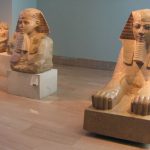Most Fascinating Pyramids in Egypt
We’re going to discover everything about Fascinating Pyramids in Egypt in detail through this virtual article from FTS press.
The pyramid is, without a doubt, the most basic image of Egypt throughout history. The masonry structures with a pyramid layout are symbolic and substantial in Egyptian culture, and they’re now among the country’s major attractions. Historians have discovered over 100 pyramids in Egypt, most of which date from the Old Kingdom and Middle Kingdom durations of Egyptian history.
Most Fascinating Pyramids in Egypt
The biggest and best Egyptian pyramids can be found in Giza, located just outside Cairo, Egypt’s capital. Nevertheless, the Giza Plateau is one of many locations where you can see historic pyramids. These antiquity constructions can be found all over Egypt, so many tourists try to see as much as possible during their tour.
Together with the well-known Great Sphinx and the Pyramid of Khufu, which most visitors would then photograph throughout their visit to Egypt, take a closer look at some of the country’s lesser known but equally impressive pyramids.
Look here: IS EGYPT SAFE FOR TRAVEL?
Pyramid of Userkaf
The Pyramid of Userkaf was built between 2494 and 2487 BC during the reign of Userkaf, a Fifth Dynasty pharaoh. Presently, the Pyramid of Userkaf is in ruins and resembles a conical sand hill rather than a truthful pyramid.
The Pyramid of Userkaf was a configuration that differentiated from the Fourth Dynasty pyramids and captivated the later Fifth Dynasty pyramids in many aspects. Userkaf did keep the complex’s conventional tall wall and the viaduct connecting one tomb to the primary pyramid. Nevertheless, it also tried to introduce novel concepts such as a north-south axis orientation and the inclusion of a small chapel outside the pyramid instead of inside.
The Pyramid of Userkaf was regained and used as a cemetery by Rameses II more than 1,5000 years after it was built. In more recent times, the opening to the pyramid was found in 1831, but nobody joined until 1839.
Pyramid of Lahun
The Pyramid of Lahun, also called el-Lahun, was built around 1180 BC during the reign of Senusret II of the 12th Dynasty. El-Lahun implies “Mouth of the Canal,” which is located on the water. This pyramid is currently in ruins, and the internal pedestrian overpasses and passageways are mostly destructed and unreachable. Even during the 1840s, when adventurers were eager to discover and document so many Egyptian pyramids as potential, British archeologist Sir Flinders Petrie spent months just finding the entrance to the pyramid itself.
Even though the north side is the traditional entry point for religious reasons, the opening to the Pyramid of Lahun was concealed in the yard on the structure’s south side.
Despite the lack of evidence, the exterior of the Pyramid of Lahun is thought to have been encased in adorned granite. The Pyramid’s organic sandstone foundation was utilized as an adequate base to make construction easier than usual. A smaller black granite pyramid was probably sitting at the structure’s apex.
Look here: How to Enjoy a Perfect Vacation in Egypt With Friends
Hawara Pyramid
The Pyramid of Hawara, located three hours south of Cairo, was built by Amenmehat III, the 6th Pharaoh of the 12th Dynasty. Historians think the Pyramid of Hawara was constructed around 1850 BC, trying to make it roughly 3,865 years old today. The Pyramid of Hawara is also known as the Black Pyramid since it appears much darker than other Egyptian pyramids from the period.
The Pyramid of Hawara was roughly 60 meters (200 feet) tall when it was first constructed, though erosion and wilderness sands gradually lowered its height over time. Pharaoh Amenmehat III did not build the first pyramid, Hawara. His first, Dashur, was a failure and collapsed briefly after building projects. Consequently, the Pyramid of Hawara is constructed at a lower angle to avoid collapse. Also, this 2nd pyramid is now nothing more than an eroded, vaguely pyramidal hillside of mud brick.
An interesting side note about the Pyramid of Hawara, which still stands but no longer has a sharp apex, is that it began to recognize and attempt to deceive tomb robbers. The Pyramid of Hawara used a labyrinth pattern of passages to confuse and frustrate prospective robbers in ancient Egypt.
Teti Pyramid
Another robust framework in Saqqara’s pyramid areas is the Pyramid of Teti. Teti, constructed between 2345 and 2333 BC during the 6th Dynasty, was the 2nd Egyptian pyramid encompassing Pyramid Texts or magical spells authored or carved into the tomb walls.
The Pyramid of Teti is ruined from above ground, and it may even be confused for a slight hill rather than a pyramid framework. Fortunately, the underground hallways and chambers are in significantly good shape and have been remarkably maintained over time. Despite the loss of the temple complex, the Teti’s Room of the Greats, this same inner chapel usually contains five different statues of Pharaoh Teti, the long descending hallway leading to the burial chamber, the burial apartment complexes for the pharaoh, as well as the Pyramid Texts inscriptions on the walls are still visible.
Pyramid of Unas
The Pyramid of Unas can be discovered in the Saqqara region. The Pyramid of Unas was constructed in the 24th century BC for Pharaoh Unas, the final leader of the Fifth Dynasty. The Pyramid of Unas was initially 43 meters (141 feet) tall, but it is now mostly ruined.
The Pyramid of Unas is substantial in portion because it was the first of its type to include what is now known as Pyramid Texts. The pharaoh had magical texts carved into the walls to safeguard him in the afterworld. Several pharaohs after Unas did the same thing, establishing a standard practice among Egyptian kings.
Pyramid of Meidum
Medium now has three visible steps or tiers. It lacks a steep apex at the top, so many Egyptians refer to it as a el-heram el-kaddaab, or pseudo pyramid. The Pyramid of Meidum, on the other hand, is well worth a trip. You’ll walk down a tunnel backed architecturally by wooden beams and into the unfinished burial chamber as you enter. A collection of mastabas, or burial sites, made of mud mortar surrounds the pyramid. These relatively small tombs represent the base of a pyramid, and many of them have tunnels robbers used to thieve from the burial mounds centuries ago.
Pyramid of Menkaure
The Pyramids of Giza comprise three different components: the Pyramid of Khufu, the Pyramid of Khafre, and the Pyramid of Menkaure. Menkaure’s Pyramid is by far the smaller of the three. Nevertheless, it has a special place in the Giza floor plan and is well worth a visit if you’re in the region.
This 65-meter-high Pyramid was constructed in 2510 BC for Fourth Dynasty Pharaoh Menkaure (213 feet). The Pyramid of Menkaure is thus approximately half the altitude of its contemporaries. The Pyramid of Menkaure was built with red granite, employed in the Pyramid’s bottom portion.
Pyramid of Djoser
Saqqara, about 25 kilometers (15 miles) south of Cairo, has a pyramid field containing some of the oldest pyramids in Egyptian history. The Step Pyramid of Djoser, regarded as the world’s most senior cut-stone framework, is one of the most iconic monuments for Egyptologists, archeologists, and architects alike. Imhotep, the ruler of Pharaoh Djoser, built the Step Pyramid of Djoser during the Third Dynasty, which was finished around the 27th century BC.
Once compared to the standard image of an Egyptian pyramid, the Pyramid of Djoser stands out. On the other hand, Djoser is a step pyramid with smooth edges.
The whole Djoser complex was encircled by a limestone wall with fourteen doors constructed into it. Nevertheless, there was only one entrance, and the residual doors could have been purely decorative or a ruse to fool passersby into allowing unwanted access. Other notable features of Djoser include a large trench that surrounds the complicated and ornate stone pillars in the roofed colonnade corridor that were sculpted to represent reed packages.
The Djoser building’s South Judge is a large area created to separate the pyramid from the South Tomb. The South Court still has contoured stones linked with the Heb-sed festival, which were positioned there to assist the pharaoh in extending his reign over Egypt.
Bent Pyramid
Dahshur is Egypt’s most historically important pyramid research area, after Giza and Saqqara. The Bent Pyramid, situated in the center of Dahshur, was constructed around 2600 BC during the rule of Pharaoh Sneferu of the Old Kingdom. The Bent Pyramid gets its name from the way it was built. The building’s foundation rises from the sand surface at a 54-degree angle, but still the top section is closer to 43 degrees. As a result, the pyramid appears to be bent or tilted with one side. The Pyramid of Sneferu, or the Southern Shining Pyramid, is its official title.
There are various theories about the bent essence of the pyramid, but only a few historians think it was a significant error.
Instead, the transition in angle could be credited to the pharaoh’s bad health, which also required the pyramid to be completed in less time, or it could be a precautionary measure to avoid an impending demise caused by the steep angle of the initial building. It could also be the consequence of the nearby Meidum Pyramid collapsing, which also fell due to its unusually steep slope.








